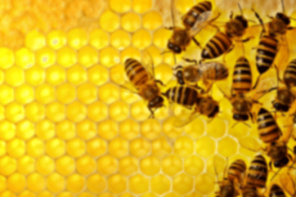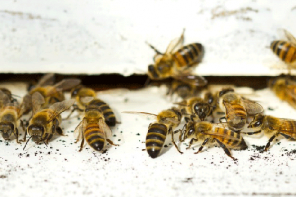I guess I’ll blame it on Sunspots maybe. Or the crush for time before our trip to New Zealand. Maybe just a too-long Winter. I’m not sure what happened in the March issue’s Inner Cover, or other parts of that issue either. Certainly it wasn’t me that caused the following problems.
Let’s see. Start with the math. I’m not a mathematician by any stretch, but numbers are an important part of what we do here, and it’s the numbers of the beekeeping industry that are important every year when we look at per capita honey consumption, coming in May, and our monthly honey report stats and more every month. But last month I goofed up on something I don’t usually goof up on. I was looking at urban land use. And I figured it wrong.
To set the record straight. Between 1945 and 2012, urban land use increased 363%, (not 78%) from 15 million acres to just about 70 million acres, while the population increased from 140 million people to 314 million, or 124% (not 54%). So land use more than tripled, while population more than doubled. I did get the jist of it right though – there are more people, and we are taking up more space per person.
And Frank’s article on Ventilation. That got messed up too. Some of it actually was my fault, but I can honestly say, some of it happened after we signed off on it. Nevertheless, we’ll fix it on the web page, so if you want all of his article, look for it on BeeCulture.com.
•
I mentioned New Zealand, because we were hosted for 12 days in that fabulous place by a whole lot of good people. They were ambitious in their planning, and efficient, too, in that we landed at the northern end of the North Island, and worked our way south, stopping in four places to meet with beekeeping groups before heading home. Each place we stopped was as different from each other as they were different from Ohio, so there was an overwhelming array of weather (it’s summer down there) landscapes, cultures and vegetation, all alien but somewhat similar, yet all different and unique. If you’ve seen the Hobbit movies, or the Avatar movie you have a feel for the landscape. Huge trees, towering steep volcanic hills, rich lush vegetation, sweeping meadows – it’s all there. And the ocean on all sides, constant wind and rushing clouds.
I was invited there to address, primarily, the issues they are facing with the gold rush of manuka honey. The manuka plant is native to both New Zealand and Australia, and it is a weed, growing in places no other plants can or will grow. It’s found on steep volcanic mountain hillsides, between rocks on cliff sides, almost anywhere that nothing else can grow, or be used for. It is a shrub, three to five feet tall or so, depending on the soil, the wind and taller foliage cover.
The issues stem from the value, and the quality of the manuka honey that’s harvested. If hives are placed in locations where only manuka grows, are moved in just after bloom begins and honey harvested just before bloom ends, and the variety of the manuka plants are right (there is more than one variety and occasionally they intermix), the finished crop can be worth more than $20 per pound. On a good location, with the right number of hives, you can make 50 – 60 pounds/hive in about two weeks, and you can put a lot of hives in a dense planting.
Some, me included, have compared it to the California Gold Rush in the late 1840’s. Thousands of people rushed west to find gold and fame and while some did, many didn’t and went bust, many were swindled out of their claims, many were murdered and their lot stolen, and most barely broke even. Those who did the best were often the smartest, the luckiest, or those who got away with the crimes. But the winners, after all the dust had settled, were the folks selling food, picks and shovels and gold mining gear. They didn’t go for the gold, they went for the sure thing. And most of them won.
This manuka rush has led to an incredible increase in the number people keeping bees in that country, and an even more incredible number of beehives being used to harvest this crop. When you look at New Zealand’s topography, you will note there are only so many places you can put beehives because the terrain only provides just so much flat space. Volcanic in origin, the whole of the landscape is extremely hilly, with steep, rocky hillsides dominating the land. Given that, a couple of untoward behaviors have arisen that New Zealand beekeepers are concerned about.
First, it’s been essentially an invasion of beehives with all the new beekeepers. More dramatic has been the expansion of existing commercial operations. It’s more common there than here for large honey packing operations to run their own hives, or at least a lot of them, and then buy in what they need. That practice has expanded exponentially to the point that these large, well-funded, deep pocket operations are moving into more and more manuka areas. This in turn is doing a couple of things. First, it is saturating an area that was supporting a given number of hives with now five and 10 times the number it can handle. The bigger companies can support short crops for a bit, while smaller operations will fold, leaving the future, and the location, to the big guys.
Second, in the past, smaller operations would put their hives on places a land owner couldn’t use for crops or sheep or cattle grazing, and pay rent in honey. Now, smart land owners are not only asking for huge fees for rent, but also a portion of the harvested crop. Big guys can pay, little guys can’t.
A similar trick is to simply set down a dozen pallets on a likely piece of land. Don’t ask, don’t pay and don’t tell. It works mostly because lots and lots of land there is simply not used for anything. Volcanic mountains, dry, dry hillsides all work for a helicopter landing and pickup when ready. Nobody knows, except the pilot and the beekeepers.
And third, outright theft. Hives disappearing in the night. Especially hives full of manuka honey. Why do the work, when you can simply steal the crop? Maybe the whole hive, but often, just the honey. Take it home, extract and it’s all yours. Electronic devices planted in some of the remote hives have helped slow this trend, but there are parts of this island where there is absolutely no digital communication so that stops some of the preventive efforts.
Of course there is some suspicion that there’s a lot more manuka honey sold than is harvested. Early on that was a given I was told, but the science behind identification has gotten a lot better, fast, and it’s not quite as easy to pawn off a barrel of honey with manuka on the label. If it is the good stuff, it’s thixotropic, like heather honey, and sets up like jelly. You need special equipment to harvest it, which we’ll look at next time. But other NZ honeys do the same, so that’s not the deciding factor, either.
Another side of this is the wave of new beekeepers who don’t know how to keep bees yet. They are learning, but you know that story. Of course they have Varroa there, and now, with so many more beekeepers, and beehives, spreading that beast has become so much easier. So that’s an increasing problem, but AFB is an even more talked about issue. There are no antibiotics used there. None. Zero. Zip. It’s burn, baby burn. Not a bad choice in my opinion, but there are no options. You can’t scorch the boxes and covers either. It all gets burned.
Of course with the influx of all these new hives, by both experienced and inexperienced beekeepers the incidence of these pests occurring, and spreading, has increased as much as the number of hives, so that’s a troubling issue too. Varroa bombs in the cities, crashing hives in the wilds, and AFB always waiting in the wings.
That was the venue I was invited to address. What a challenge. What an opportunity. What a trip. But the request, actually, was more in the line of “let’s talk about beekeeping ethics in general”. Which, I learned, came from a talk I’d done at an EAS meeting not long ago that the good people from New Zealand had heard, and thought needed a wider audience.
“Ethics”
Beekeeping ethics? Well, yes. Let’s explore that should we?
This centered on honesty, safety and common sense of being in the bee business. Treating fairly customers, consumers, the uninformed and unprotected public, growers, other beekeepers and even yourself.
So, customers. Do you sell queens, nucs, packages, colonies? Are they what you say they are? Are your queens well mated? Did you keep them long enough to know they are good layers, or sell them just as fast as you could get them out of their cells? Clean wax in your nucs, or the old stuff you want to get rid of? Pest free hives, or, whatever, because they don’t know the difference anyway? Guarantee those queens or tail light guarantee?
How about your honey? Sell a varietal? So a varietal is classified as the ‘predominant’ variety in the mix. So, a honey could be a mix of 10 blossoms, with one, at 11%, the predominant variety. Is that what you are going to call it? And do you filter your honey, and is honey, honey if it doesn’t have pollen in it? Or do you have a good varietal crop, and dilute it with an unflavored variety (or worse), so it still looks and kind of tastes like fireweed, but it’s only, now, the predominant variety, sold as pure? That’s never happened.
And then there’s the unknowing, and unprotected public? Ever get a robbing situation going in your backyard and simply retreat, leaving everybody else to fend for themselves? Or travel with a ‘oh that’s good enough’ unsecured load of bees, or honey, or equipment, or whatever?
How about pollination contracts? You promised eight frames, but most are only six, so only show the eights, right? You don’t have anything written down promising eight, just a phone call a couple weeks ago from the grower. Who’s to know? He never comes out to look, anyway.
And the most recent one I ran into. I delivered magazines to give away at a beginner’s class. Got there just as the class was getting underway so stayed a bit to see how it was going. First slide up was from a talk of mine that was on the internet, as were all the rest. No credit given, no mention of where it came from, not even an embarrassed speaker. I’m going to guess that’s not the first time that’s happened, either.
So, ethics. You don’t have to go all the way to New Zealand to see issues with this. They are right next door.
•
Next time we’ll look at the magic of Manuka honey. It is special.









